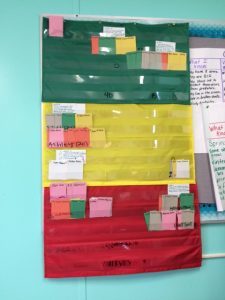Finding and Fixing the Missing Skills at Greenhurst Elementary School
CompetencyWorks Blog
 This is the fifth article in the series on Mastery Education in Idaho. Links to the other articles can be found below.
This is the fifth article in the series on Mastery Education in Idaho. Links to the other articles can be found below.
Greenhurst Elementary School in Nampa School District a bit outside of Boise is well into their journey toward mastery-based learning. (FYI, they use the term personalized to refer to the use of instructional technology.) The core features of their model are multi-age, targeted instruction, and flexible grouping. The clearest indicator that they understand the core concept of mastery-based learning was a large chart on the wall that grouped third through fifth grade students according to the prerequisite skills they needed in order to complete the fifth grade learning objective. They were taking the time to understand where students are and repair the gaps (whether it was one or many) on the way toward reaching grade level proficiency.
Our conversation with Rachel Lightfoot, Mastery Based Education coach and Math instructional coach, regarding their effort to meet students where they are and repair gaps was fascinating. The chart was organized around a competency: measurement. The teachers had identified the trajectory (or progression) of prerequisite standards that were related to measurement from the second to the fifth grade performance levels, including drawing a picture graph, converting, and making a line plot. This is where the value of competency comes into play rather than just standards. The competency, the larger concept of students having the knowledge and skills related to measurement, contains a vertical progression of skills. Thus, the teachers were shifting away from covering the curriculum or covering the standards to ensuring that students were building the knowledge and skills they needed to be competent (or master) the skills as established at their grade level. One teacher described it as “the road” we need to follow for students to be successful.
 They then did a pre-assessment with students in grades three through five, grouping them around the standards (stretching from second grade to fifth grade) that they had not yet mastered. On the wall chart, they pinned every student name on a slip of paper, color-coded by teacher, at the lowest level needed in the standard they had not yet mastered. Teachers who were particularly skilled in teaching specific standards worked with the students needing those skills. As students built skills, they would be regrouped based on their individual needs. As students complete the lower level skills, they begin to ‘level up’ and are able to demonstrate proficiency in second grade, third grade, and fourth grade in relatively short periods of time, simply because the gaps are getting filled.
They then did a pre-assessment with students in grades three through five, grouping them around the standards (stretching from second grade to fifth grade) that they had not yet mastered. On the wall chart, they pinned every student name on a slip of paper, color-coded by teacher, at the lowest level needed in the standard they had not yet mastered. Teachers who were particularly skilled in teaching specific standards worked with the students needing those skills. As students built skills, they would be regrouped based on their individual needs. As students complete the lower level skills, they begin to ‘level up’ and are able to demonstrate proficiency in second grade, third grade, and fourth grade in relatively short periods of time, simply because the gaps are getting filled.
Lightfoot explained, “It was clear, if students did poorly on one of the lower standards, they weren’t going to be able to complete the fifth grade level. But once we fill the gaps, they can do higher levels. Although we knew it, this process really clarified for all of the teachers that students had to know all of the standards below to be successful at grade level. You could keep trying to teach the upper level standards, but most likely students were not going to be successful unless we helped them learn the lower ones. So we had to find a way to address the missing skills. It’s really all common sense. But we’ve never taught this way before. What’s amazing is that even the kids with behavioral issues are more engaged. They are feeling successful and they are really working hard.” She continued, ”We’ve always used pre-packaged curriculum before. The emphasis was in implementing it with fidelity and according to the pacing guide. But the starting assumption is all wrong. They want every student doing the same thing at the same time. But that’s never going to work if students are missing one or several of the skills they need to be successful.”
In general, they spend about two weeks on a trajectory as described above with an assessment at the end. They know what students learned and how far they are in the trajectory, with the assumption that they will refresh and continue on with the learning the next time they focus on measurement. For students reaching fifth grade performance levels, they either support them in pursuing high levels of measurements skills or focus on where students might be weak in other areas.
She emphasized, “This process is successful only if you commit to a strong instructional approach and to not passing students on without helping them. Oftentimes, students have misconceptions, and it is important that teachers can identify the misconception and provide effective feedback.” To build the capacity of Greenhurst to use learning progressions in this way, every teacher has taken a class at Developing Mathematical Thinking Institute at Boise State University The Institute, led by Jonathan Brendefur. The hope is to introduce project-based learning in the future so students have more opportunity to apply what they are learning.
Discussion periodically touched on what type of data is helpful for whom and when. The ISAT scores are returned at the end of the school year. They are used as a summative assessment of student progress. Once a school has set up the system to meet students where they are, teachers already have some information about where students are in terms of proficiency. However, teachers need to look more closely to understand what students need help with to address the gaps. One teacher suggested that what they need to be looking at is a combination of growth on standards and time spent learning each standard.
As in many of the schools visited in Idaho, the introduction of mastery-based learning in Greenhurst has opened the door to questions about other habits and routines of the traditional school system. For example, one teacher asked, “Why do we only focus on reading and writing informational text for one week? What if students need to build up some other skills to do that well? What if it does take us more time? Isn’t it more important for us to make sure students are successful? Honestly, should a textbook drive the learning, or should the student?” Greenhurst is now moving toward units with activities and assessments aligned with each standard and that are able to be used as needed to respond to students. There are discussions about multi-age bands and more autonomy around scheduling.
Read the Entire Series:
- Part 1 – Mastery-Based Learning in Idaho
- Part 2 – Finding Synergy at Kuna Middle School
- Part 3 – Moving Forward toward Mastery at Kuna School District
- Part 4 – Increasing Credits Earned at Initial Point High School
- Part 5 – Finding and Fixing the Missing Skills at Greenhurst Elementary School
- Part 6 – Columbia High School: How a Comprehensive High School Becomes Mastery-Based
- Part 7 – Gathering Insights on Mastery-Based Learning from Columbia High School
- Part 8 – Slaying the Dragon: A Conversation with Cory Woolstenhulme on Mastery-Based Learning
- Part 9 – Central Academy, West Ada School District
- Part 10 – The Sharp Ones: A Few Takeaways from Idaho